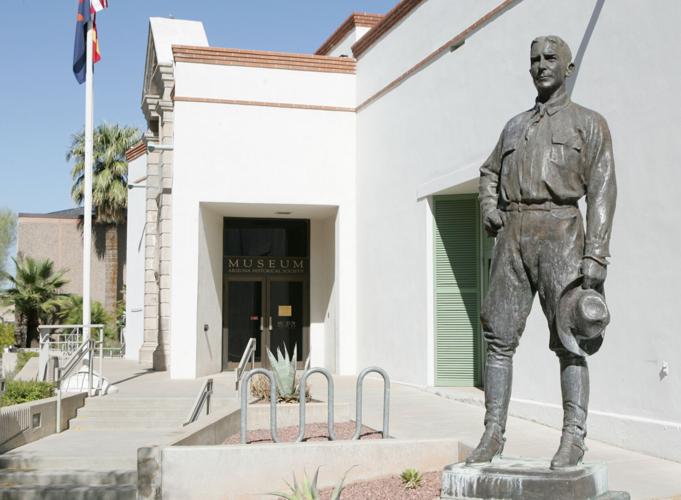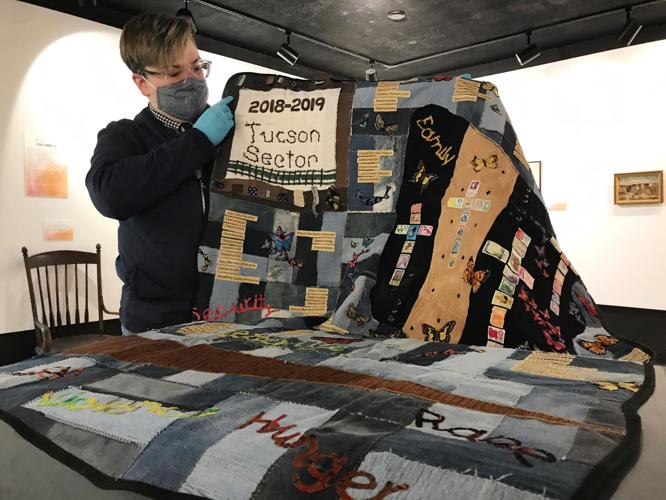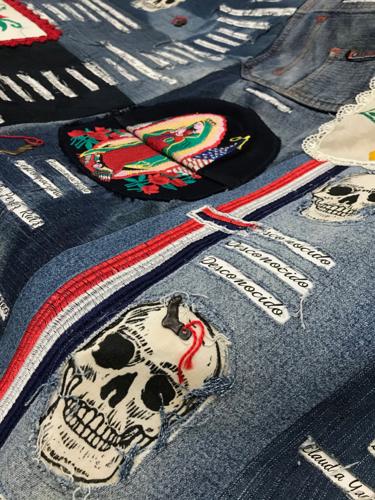Statehood Day is coming early this year, so don’t forget the flowers and the chocolates.
Arizona’s actual 111th birthday is on Feb. 14, but the Arizona Historical Society has decided to celebrate on Feb. 4 instead with free admission to Arizona History Museum in Tucson and the Arizona Heritage Center in Tempe.
“We felt that no one would be interested in bringing their family to the museum on Statehood Day, which is not only Valentine’s Day but a Tuesday,” said Jaynie Adams, history engagement coordinator for the historical society.
The weekend before Feb. 14th is Super Bowl weekend in Phoenix, so that was out, too, Adams said. “There is a method to the madness — promise!”
The two museums will be open from 10 a.m. to 2 p.m. on fee-free Feb. 4.
The Arizona History Museum at 949 E. Second St. in Tucson will feature statehood-themed artifacts, as well as displays dedicated to Barry Goldwater’s Ham radio, copper mining, and an interactive tour of Tucson in the 1870s.
Visitors also will be able to handle archival materials, take a virtual scavenger hunt through the museum and check out the community mural project in the lobby.
The event provides one of the last chances to see the Migrant Quilt Project exhibit, which closes at the end of February.
That display features 20 intricate quilts stitched together from clothes abandoned on Arizona’s migrant trails to honor those who have died crossing the desert in search of a better life.
The ongoing textile tribute is the work of more than 50 artists. Each quilt memorializes the migrants whose bodies were found — but, in most cases, never identified — during a single federal fiscal year in the Border Patrol’s Tucson Sector, which extends from the New Mexico state line to the eastern edge of Yuma County.
The Arizona Heritage Center at 1300 N. College Ave. in Tempe includes On Air, an exhibition about the Valley of the Sun’s history of broadcast news, and the brand new Rebuilding Home Plate, about baseball in Arizona’s Japanese incarceration camps.
How well do you know Arizona? Here is another quiz to test your knowledge on Arizona history and facts. Video by Pascal Albright / Arizona Daily Star
Look back: Here's what downtown Tucson once looked like
Downtown Tucson buildings
Updated
The Legal Tender bar Barbary Coast night club at 80 W. Congress on July 12, 1968. The area is now the county courts and administration buildings.
Downtown Tucson buildings
Updated
Downtown Tucson buildings including Tucsonia Hotel, Miller's Army Surplus and Gold Furniture on June 1966. The block was demolished to make way for new government buildings.
Downtown Tucson buildings
Updated
Downtown Tucson buildings in the late 1960s, including the Lyric Theater at 171 W. Congress St., Lyric Outfitting and La Selva Club. The site is now home to the Federal Building. The Tucson Federal Savings and Loan Building on Stone Ave. towers in the background. It was the tallest building in the city from 1967 to 1977. It is now the Pima County Legal Services Building.
Downtown Tucson buildings
Updated
Greyhound Bus Station in on Stone Ave. between Congress and Broadway downtown Tucson on July 12, 1968.
Downtown Tucson buildings
Updated
Carrillo Mortuary on S. Stone Ave. in Tucson on July 12, 1968.
Downtown Tucson buildings
Updated
Urban Renewal Model on October 17, 1965. In the City Court House, Mayor Davis displays model of the city, which was shot looking North. In the picture, is the building which will house the Mayor's office. Note the east-west urban freeway at the bottoms of the model, likely the Cushing/14th Street alignment.
Downtown Tucson buildings
Updated
Tucson Army Surplus Store at 42 S. Meyer, south of Broadway in downtown Tucson on July 12, 1968. It's now La Placita office complex.
Downtown Tucson buildings
Updated
Downtown Tucson buildings including Desert Leather Wear in June 1965. The building at far left was replaced by a city parking garage that housed the now-closed Cafe Poca Cosa.
Downtown Tucson buildings
Updated
A closed down Del Monte Market on Meyer Street probably at Ochoa St. in downtown Tucson on July 12, 1968. The area is now part of the Tucson Convention Center.
Downtown Tucson buildings
Updated
The Plaza Theater (lower right) at Congress and Court streets in downtown Tucson on May 28, 1968, at about where the Garces Footbridge now stands, Photo taken looking south from the current site of the Pima County courts and administration complex. St. Augustine Cathedral is upper left. The loop drive known as Avenida San Augustine and buildings in that block were demolished to make way for Veinte de Agosto Park, which divides Congress and Broadway.
Downtown Tucson buildings
Updated
Downtown Tucson buildings in 1960. Holloways Southwest Auto Service was listed as 247 N. Stone Ave., which is now a Pima County building.
Downtown Tucson buildings
Updated
Flores Nacional (formerly Farmacia Flores) in downtown Tucson on July 12, 1968, on Congress St., at Main Ave., what is now the parking lot for the former Arizona Hotel.
Downtown Tucson buildings
Updated
Downtown Tucson buildings on Broadway looking west from 6th Ave. including Hotel Roskruge, Chevron gas station and the original Federal Courthouse building on Broadway Road in June 1965, as the Tucson Federal Savings and Loan Building rises in the background.
Downtown Tucson buildings
Updated
The historic Santa Rita Hotel on Scott Ave at Broadway Road in February 1954. The main hotel was building in 1904. It is now the site of the Tucson Electric Power Co. headquarters.
Downtown Tucson buildings
Updated
Midtown Market and Liquor Store on Stone Ave. on July 12, 1968. It's now the spot of the parking lot for the Tucson Police Dept. headquarters.
Downtown Tucson buildings
Updated
Downtown Tucson buildings on Broadway Road in June 1965. The old Federal Courthouse at Scott Ave. is at right. The buildings in foreground have been replaced most recently by the Pima Association of Governments building.
Downtown Tucson buildings
Updated
Downtown Tucson buildings including Stein's Clothiers and Leed's Shoes in May 1953. Picture taken from Stone Ave. looking north at Congress St. The corner where Stein's is pictured is now occupied a former US Bank branch.
Downtown Tucson buildings
Updated
Downtown Tucson buildings at Congress and Meyer in June 1966. Now, Meyer dead ends at Cushing Street. This corner is now the La Placita office complex.
Downtown Tucson buildings
Updated
The Pioneer Hotel along Pennington St. as seen from Scott Ave, probably in the 1950s. The building at left now houses Cafe 54.
Downtown Tucson buildings
Updated
Downtown Tucson buildings including Aaronson Brothers (now the Chicago Store) and the Valley Bank on Congress St. in June 1965.
Downtown Tucson buildings
Updated
An old building to be demolished on Alemeda and Meyer on January 2, 1968 during urban renewal efforts in downtown Tucson.
Downtown Tucson buildings
Updated
Urban Renewal- West Congress on December 29, 1966. The county administration and courts complex and Tucson city hall is under construction at right, after a block of vintage buildings including the Plaza Theatre were cleared out.
Downtown Tucson buildings
Updated
A gas station in downtown Tucson? How convenient. It was the Don Jones Gas Station, at the southeast corner of Church and Alameda on January 12, 1967. Note the vintage Tucson Police cruiser at right.
Downtown Tucson buildings
Updated
Urban Renewal- The old YMCA building at Court and Congress on October 7, 1966. It was demolished to make way for the new Pima County complex, including superior court and county administration.
Downtown Tucson buildings
Updated
Downtown Tucson buildings including Greater Arizona Savings and Loan on Stone Avenue at Broadway Road in June 1965. The St. Augustine Cathedral is background left.
Downtown Tucson buildings
Updated
Downtown Tucson buildings including the Plaza Theatre and Imperial Home Furnishings in June 1966. The Plaza was demolished in the late 60s as part of "urban renewal."
Downtown Tucson buildings
Updated
Downtown Tucson buildings on Scott Ave north of Congress St. Photo taken June 1965.
Downtown Tucson buildings
Updated
Downtown Tucson buildings including Consumers Market on South 6th Ave. in 1953. It was designed by noted Tucson architect Merritt H. Starkweather, who designed several Tucson schools and co-founded the Tucson Rodeo.
Downtown Tucson buildings
Updated
Downtown Tucson buildings including the Skyroom at Stone and Alameda in June 1965. It is now a Pima County building.
Downtown Tucson buildings
Updated
Downtown Tucson building. June 29, 1964.
Downtown Tucson buildings
Updated
Downtown Tucson buildings including what is now the Wells Fargo Bank on Stone Ave., taken June 1965.
Downtown Tucson buildings
Updated
Urban Renewal area buildings in downtown Tucson on July 12, 1968.
Downtown Tucson buildings
Updated
Urban Renewal area buildings in downtown Tucson on July 12, 1968.
Downtown Tucson buildings
Updated
The Plaza Theater, 132 W. Congress St., was demolished in 1969. It featured Spanish-language films near its end. It was designed by local architect Roy Place and opened in 1930 with seating for 650 people.
Downtown Tucson buildings
Updated
Plaza Ends 40-Year Run- Demolition of the Plaza Theater, 132 W. Congress St., on May 14, 1969. The movie house, which featured Spanish-language films near it end, was torn down to make way for the widening of Congress Street, part of Tucson's urban renewal project.
Downtown Tucson buildings
Updated
Urban Renewal- Remains of the old Tucsonia Hotel at North Main Avenue and West Congress Street were hauled away on November 29, 1966 as site clearance for new Pima County office buildings. A new county morgue and central utility plant, a health-welfare building, administration and courts building were planned for the spot.
Downtown Tucson buildings
Updated
Downtown Tucson buildings including the historic Fox Theater on Congress St. in June 1965.
Downtown Tucson buildings
Updated
And It Looks Good, Too- The new $500,000 Downtown Shoppers' Garage on December 9, 1958 In addition to handling more than 370 automobiles, it lends its colorful panels to the Tucson downtown scene. The building was designed by architect Terry Atkinson.
Downtown Tucson buildings
Updated
Phoenix Title and Trust in January 1956.
Downtown Tucson buildings
Updated
A Ticket For Everybody on December 9, 1958- There's no margin for error as the ticket dispenser is completely automatic. Upon entering, the customer's automobile passes over a bar in the floor which trips the machine into handing out a ticket. Don Jones, manager of Harold Steinfeld's garage, stands beside the machine.
Downtown Tucson buildings
Updated
The Fox Theatre at West Congress Street, people waiting for their bus to arrive on December 30, 1980.
Downtown Tucson buildings
Updated
The Roy Place Building, which housed S.H. Kress & Co. at Stone Ave. and Pennington St. in downtown Tucson in January 1955. It was built in 1929 as a Montgomery Ward. It became a Walgreen's pharmacy, was covered with a facade, but has now been restored. It is occupied by University of Arizona College of Architecture and Landscape Architecture
Downtown Tucson buildings
Updated
Downtown Tucson buildings including Grand Central Public Market and Tucson Realty and Trust in June 1965.
Downtown Tucson buildings
Updated
Downtown Tucson barrio in 1962.






